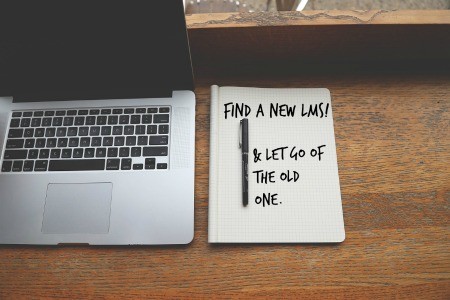Our instructional technology department was new in 2009. And almost immediately we were interested in a Learning Management System (LMS). I remember asking our technical counterparts about Moodle and the resistance with which that was met. It was obvious the technical side was not looking to take on more work for a more usable classroom technology presence. And in fairness, maybe that is what they were told we were going to do.
When Moodle was removed as an option we started to investigate what options were available to us and what the cost would be, both in personnel and funding. A district nearby shared their solution with us, Angel, and what they were doing with that LMS. However, Angel was then acquired by BlackBoard. And having already heard from Blackboard we knew we did not want Blackboard for a LMS.
We gave BrainHoney a look; at the time it was a great solution for us. A couple years after that we added a Dell user Interface on top of BrainHoney, building it as we used it. Until we didn’t want to use it anymore and we put out a Request For Proposal on a new LMS in the Spring of 2014. At that time we selected Canvas (over Its Learning, Desire2Learn, and Infinite Campus) as our newest LMS.
Through all of this there are many lessons worth noting, if you are going . Here are some of the top level realizations I had through our process:
Assessment
Educators are typically good at assessment. So it was little wonder that many teachers wanted to start by adding their assessments and then aligning instruction to those assessments. It became rapidly clear that teachers did not like click-intensive assessment entry, even advanced entry was problematic as it was more technical than intuitive for teachers. Lesson: No LMS really does assessment well. It is time consuming and cumbersome; and then what you are left with is your assessment trapped in a proprietary platform – good luck extracting it. Look at a solution like MasteryConnect instead. It takes your assessments in formats you likely already have them in, MS Word or PDF, and supplies ‘scantron technology’ to your computer camera for the printed bubble sheets or allows your students to test on mobile/Internet devices as well. Although the full-blown product is pricey, you can do 10 question assessments for free. Surprise, MasteryConnect has teamed with Socrative for a LMS-like experience (see my related post on the tipping point & how everybody and their dog offers a LMS now-a-days).
Standards
One of the features I had liked about BrainHoney from the beginning was their standards mastery view. I did not realize that feature would really only benefit a classroom with all assignments, assessments, everything in the LMS. So, if teachers want to utilize that feature they would have to enter every single assignment. Lesson: If you are a K12 public school you are more likely to be practicing blended learning than online learning. Duh you say? Well, To essentially maintain your LMS as a comple book to get the standards mastery view is not a time sensitive task for teachers.
Additionally, the standards you use themselves made a huge difference. You do not want to get in the game of manually entering standards. Of course that is fraught with peril. Lesson: You need all your standards to match. Of course using standards someone else has written might not be the perfect solution either. Open Educational Resource, OER, standards such as Achievement Standards Network, ASN, are not of the same quality as paid resources like Academic Benchmarks. Additionally, look at the integration you want to achieve within your LMS with other vendors. Most likely you find more AB companies than ASN companies.
Some LMS tag different item types with standards; BrainHoney allowed you to tag items, lesson, and assessments while Canvas only allows you to tag assessments. That, turns out, needs to be something your entire organization is on board with before you get too far down the garden path. Lesson: Establish your expectations for measuring standards, early and often.
Lesson: Most of our teachers are not trying to be online teachers, don’t make them try to be online teachers. Instead try to use mastery of standards just with assessments (see MasteryConnect again) or any one category of your grade book.
Content
Once you have established a LMS you might look around a realize there is nothing to deliver through it. That’s not such a great situation; you need to have content created outside the LMS. We use SoftChalk, a private cloud version of SoftChalk, and have been able to use content from our first LMS in our second LMS. While a LMS might allow you to bring in HTML unless you are a webmaster what are you doing with that?
I find that my content creation skills develop quickly when used, so some of my creations made during the first LMS are not longer delivery quality. However, every piece of content I have created can be repurposed and contribute to a new work easily in something like SoftChalk. I find the content changes less than my skills upgrade themselves through practice.
You might ask form a strategy to use one or two vendor’s content consistently throughout your course. Again, pay special attention to the strength of the integrations before selecting a LMS as this needs to be easy enough for most of your teachers to achieve on their own.
Lesson: You need a content authoring tool outside your LMS.
Future Plans
Moving content or full courses out of any LMS is not for the faint of heart. Do not let anyone tell you how easy it is, make them show you. If you can obtain access to two LMS and upload a lesson/course downloaded from another that is the only way you know how easy or difficult the process is. Lesson: Do not plan on a one-button escape hatch from any LMS. Even though LMS companies are constantly attempting to switch you from a competitor to them, they are not as interested in helping you move to another LMS.
You can mitigate your risk by creating and keeping content outside the LMS (SoftChalk for example) or not over invest in re-creating assessments in the LMS, which you likely cannot recover easily (instead try MasteryConnect).
Plan for a lifecycle anywhere between 5-7 years. Set up structures of best practices and transfer the ownership of the content creation to an empowered teacher base as early as possible.
Best of Luck!
I had occasion to log into our old LMS, even through access was supposed to shut off in October. It was fun to look “back in time.” I think overall we have upgraded to meet our needs. However, I like the experience of using more than one LMS to help me ask questions about instruction and evaluate the usefulness of features. I certainly learned many lessons – some more painful than others – on this journey and I am hoping they can inform some of the choices you may currently face.






Leave a Reply